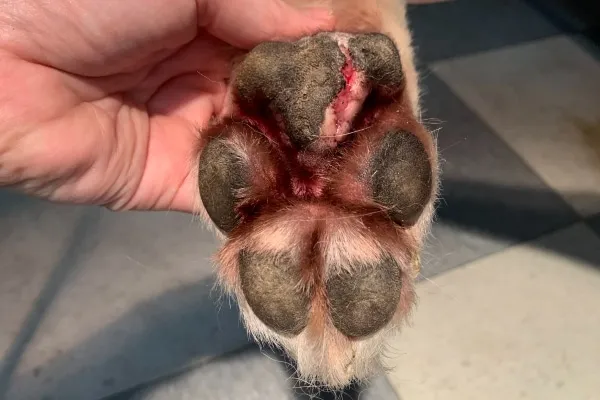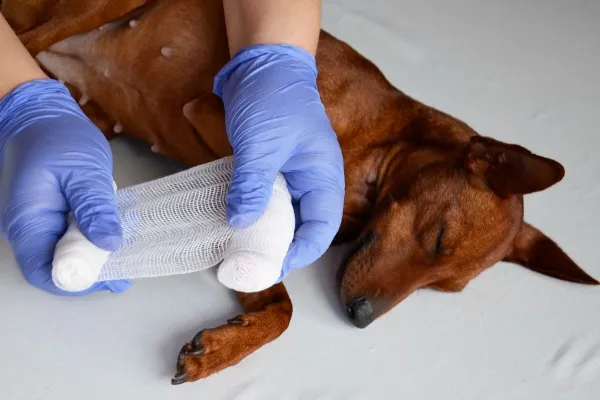A raw paw pad on your dog can be a painful and concerning issue, ranging from minor abrasions to severe burns. As a loving dog owner, knowing how to handle these situations is crucial. This guide, crafted by a pet care expert, will walk you through identifying the causes, providing immediate first aid, and understanding when to seek professional veterinary care.
 Dog with his pawpads up in the air
Dog with his pawpads up in the air
Understanding the Importance of Paw Pads
Your dog’s paw pads are essential for their overall well-being. These resilient structures act as shock absorbers, protecting their bones and joints from the impact of running and walking. They also provide insulation against extreme temperatures and offer crucial traction on various surfaces. Ignoring a paw pad injury can lead to infection, lameness, and chronic pain.
Common Causes of Raw Paw Pads
Several factors can lead to a raw paw pad in dogs. Being aware of these causes can help you prevent future injuries.
- Burns: Hot pavement during summer is a common culprit. Asphalt temperatures can skyrocket on sunny days, causing severe burns on your dog’s paws. Cold temperatures and ice melt chemicals can also cause burns.
- Abrasions: Rough surfaces like concrete or gravel can wear down the paw pads, leading to raw spots.
- Cuts and Lacerations: Sharp objects like glass, rocks, or metal can cause cuts and scrapes, resulting in a raw and exposed paw pad.
- Foreign Objects: Thorns, splinters, or other debris can become embedded in the paw pad, causing inflammation and rawness.
- Chemical Irritation: Contact with harsh chemicals like cleaning products or lawn fertilizers can irritate the paw pads, leading to a raw and inflamed appearance.
Recognizing the Signs of Paw Pad Injury
Identifying a paw pad injury early is crucial for effective treatment. Watch for these signs:
- Limping: Your dog may avoid putting weight on the affected paw.
- Excessive Licking: They might obsessively lick or chew at their paw.
- Redness and Swelling: The paw pad may appear inflamed and swollen.
- Bleeding or Discharge: You might notice blood or pus coming from the paw pad.
- Visible Injury: Look for cuts, abrasions, or foreign objects embedded in the paw pad.
- Reluctance to Walk: Your dog may be hesitant to go for walks or play.
 Close up of a dog
Close up of a dog
This dog cut her paw pad with something sharp while out on a walk
Step-by-Step First Aid for a Dog’s Raw Paw Pad
If you notice any of the above symptoms, it’s time to take action. Here’s a step-by-step guide to providing first aid:
- Assess the Situation: Approach your dog calmly and gently. If they are in extreme pain, they may bite. If necessary, muzzle your dog for your safety and theirs.
- Clean the Paw: Gently clean the affected paw with lukewarm water and a mild antiseptic soap. Avoid harsh chemicals or alcohol, as they can further irritate the raw paw pad.
- Remove Debris: Carefully remove any visible debris, such as thorns or glass shards, using tweezers. If the object is deeply embedded, do not attempt to remove it yourself. Seek veterinary attention immediately.
- Control Bleeding: Apply direct pressure to the wound with a clean cloth until the bleeding stops. For minor cuts, this should take only a few minutes.
- Apply Antibiotic Ointment: Once the bleeding has stopped, apply a thin layer of antibiotic ointment to the raw paw pad to prevent infection.
- Bandage the Paw: Protect the paw pad with a non-stick bandage. Secure it with vet wrap, ensuring it’s not too tight. Change the bandage daily to keep the wound clean. See your veterinarian’s instructions on how to wrap a dog’s paw.
 Dog getting their foot bandaged
Dog getting their foot bandaged
Bandages may be necessary to help heal your dogs injury
When to Seek Veterinary Care
While first aid can provide immediate relief, it’s crucial to know when to consult a veterinarian:
- Deep or Large Wounds: If the cut is deep or covers a large area, it may require stitches or further treatment.
- Embedded Objects: If you cannot safely remove a foreign object, a vet can do so and prevent further damage.
- Severe Burns: Extensive burns require professional medical attention to prevent infection and manage pain.
- Signs of Infection: If you notice increased redness, swelling, pus, or a foul odor, it could indicate an infection requiring antibiotics.
- Non-Weight Bearing Lameness: If your dog refuses to put any weight on the affected paw, there may be a more serious underlying issue.
- Underlying Health Conditions: Dogs with diabetes or other health conditions may require specialized care for paw pad injuries.
Veterinary Treatment Options
Your veterinarian will conduct a thorough examination to determine the best course of treatment for your dog’s raw paw pad. This may include:
- Pain Management: Pain medication to alleviate discomfort and promote healing.
- Antibiotics: To combat or prevent infection.
- Wound Care: Professional cleaning and bandaging of the wound.
- Surgery: In severe cases, surgery may be necessary to remove damaged tissue or foreign objects.
- Laser Therapy: To stimulate healing and reduce inflammation.
Preventing Future Paw Pad Injuries
Prevention is key to keeping your dog’s paws healthy and safe. Here are some tips:
- Avoid Hot Pavement: Walk your dog during cooler times of the day or use protective dog booties.
- Inspect Walking Surfaces: Be mindful of potential hazards like broken glass or sharp rocks.
- Regular Nail Trims: Keep your dog’s nails trimmed to prevent them from growing into the paw pads.
- Moisturize Paw Pads: Use a paw balm to keep the pads hydrated and prevent cracking.
- Protective Booties: Consider using dog booties when walking on rough terrain or in extreme weather conditions.
 Dog wearing paw boots out in the snow as protection from foot pad injuries
Dog wearing paw boots out in the snow as protection from foot pad injuries
Training your dogs to wear dog booties in the snow can help protect from injury
Conclusion
Dealing with a dog’s raw paw pad can be stressful, but by understanding the causes, recognizing the signs, and knowing how to provide first aid, you can help your furry friend recover quickly and comfortably. Remember to consult your veterinarian for any severe injuries or concerns. With proper care and attention, your dog will be back on their feet in no time, ready for more adventures.
